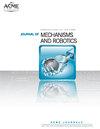基于双目视觉的XYZ-3RPS混合运动机构几何误差标定
IF 3.2
4区 计算机科学
Q2 ENGINEERING, MECHANICAL
Journal of Mechanisms and Robotics-Transactions of the Asme
Pub Date : 2023-06-05
DOI:10.1115/1.4062465
引用次数: 0
摘要
摘要为了提高XYZ-3RPS混合运动机床(HKM)的运动精度,研究了一种基于双目视觉测量的几何误差标定方法。首先,为了分别标定串联运动机构(SKMs)和并联运动机构(PKMs),分别推导了XYZ SKM和3RPS PKM的几何误差辨识方程(GEIEs)。通过分析几何误差对3RPS PKM位置姿态的不同影响原理,在PKM的GEIE中加入约束函数,提高了计算精度。此外,根据XYZ-3RPS HKM的结构特点,提出了几何误差补偿策略。此外,基于双目视觉测量原理,设计了动态标定板和静态标定板两个标定板作为标定坐标系的标记,实现了完整位置和姿态的获取。设计了标记变换法和原位平差法,确定标定所需HKM的位置和姿态,使标记始终位于摄像机视场中心,提高测量精度。最后,通过样机实验验证了标定方法的有效性。本文章由计算机程序翻译,如有差异,请以英文原文为准。
Geometric Error Calibration of XYZ-3RPS Hybrid Kinematic Machine via Binocular Vision
Abstract To improve the motion accuracy of an XYZ-3RPS hybrid kinematic machine (HKM), a geometric error calibration method via binocular vision measurement is studied. First, to separately calibrate the series kinematic mechanisms (SKMs) and parallel kinematic mechanisms (PKMs), the geometric error identification equations (GEIEs) of the XYZ SKM and 3RPS PKM are derived, respectively. By analyzing the different influence principles of the geometric errors on the position and attitude of the 3RPS PKM, a constraint function is added to the GEIE of the PKM to improve the calculation accuracy. Moreover, the geometric error compensation strategy is based on the structural characteristics of the XYZ-3RPS HKM. In addition, based on the principle of binocular vision measurement, two calibration plates, called dynamic and static calibration plates, are designed as markers to define the coordinate systems, enabling the acquisition of full positions and attitudes. Furthermore, a marker transformation method and an in-situ adjustment method are designed to determine the positions and attitudes of the HKM required for calibration such that the marker is always at the center of the field of view of the camera to improve measurement accuracy. Finally, the effectiveness of the calibration method is verified through prototype experiments.
求助全文
通过发布文献求助,成功后即可免费获取论文全文。
去求助
来源期刊

Journal of Mechanisms and Robotics-Transactions of the Asme
ENGINEERING, MECHANICAL-ROBOTICS
CiteScore
5.60
自引率
15.40%
发文量
131
审稿时长
4.5 months
期刊介绍:
Fundamental theory, algorithms, design, manufacture, and experimental validation for mechanisms and robots; Theoretical and applied kinematics; Mechanism synthesis and design; Analysis and design of robot manipulators, hands and legs, soft robotics, compliant mechanisms, origami and folded robots, printed robots, and haptic devices; Novel fabrication; Actuation and control techniques for mechanisms and robotics; Bio-inspired approaches to mechanism and robot design; Mechanics and design of micro- and nano-scale devices.
 求助内容:
求助内容: 应助结果提醒方式:
应助结果提醒方式:


